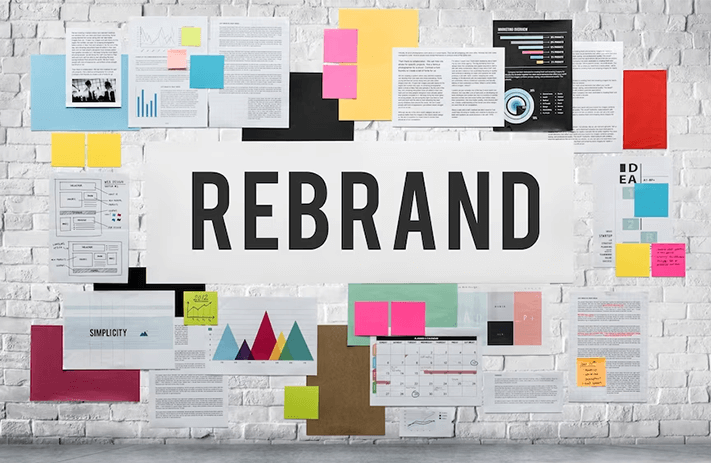
Click the button to start reading
What is Strategic Brand Management? + 6 Steps to Do It in Your Business
How important is your brand, really? You could associate branding with little more than a logo and a slogan. Something that can come later. Something that’s only really essential for more prominent companies. But we’re here to tell you that any business of any size can benefit from having a solid brand! And with your brand comes a continued effort to position yourself in the minds of consumers and maintain that image with consistent communications. That’s where these brand management strategies come in!
Your brand is so much more than just the visual elements. And in an ever-crowding marketplace, branding can be just the thing that your business is missing. That’s why today, we’re talking more about the importance of branding and strategic brand management as an ongoing part of your marketing. Ready?

What is strategic brand management?
Let’s start with the big question. What is strategic brand management?
The name says a lot. Branding is a combination of techniques meant to position a brand in the mind of customers and influence their decision-making. Brand management refers to the systems in place to manage that brand. And because it’s strategic, it’s an intentional and long-term process. Hence strategic brand management.
The ultimate goal of strategic brand management is to influence customer decision-making, increase revenue, and meet company goals.
Why does strategic brand management matter?
Branding plays a critical role in sales and marketing. While it’s often skipped over in favor of operational demands, companies who spend time on their brand earn a significant advantage. For example, branding helps you…
- Build relationships and improve the perception of your brand. Marketing is expensive. This is especially true when you’re finding new customers every time. But like any relationship, it can be built with time! It will never be as hard to connect with a customer as it was the first time. Once they are familiar with your brand and have some perception of it, the cost of marketing or effort to convert them into buyers drops significantly.
- Driving loyalty and repeat customers. As we touched on above, repeat customers are probably the best thing a growing business can hope for. Loyal customers are less expensive to acquire than new ones and work as evangelists and amplifiers of your brand. They have firsthand experience with your product or service, and if they had a positive experience, you have less work to convince them of the value of your offer. With strategic brand management, you can better stay consistent and nurture these loyal customers to keep them returning.
- Differentiating your brand. The importance of differentiation cannot be overstated! Differentiation, in this case, is your competitive advantage. It’s the thing you do best (or the way you do it) that your competitors can’t easily compete with. With intentional branding and careful brand management, you’ll be able to play to your strengths and build upon them in the eyes of your customers. It also helps make your marketing message more memorable.
- Clearer and more impactful marketing message. A clearly defined brand allows you to be more straightforward and impactful in marketing. Rather than starting every campaign or message with a blank page, brand guidelines, and attributes will enable you to be more precise, consistent, and personality-driven in your marketing message. With repetition and consistency, you start to define yourself in the eyes of your consumers so they know what to expect and how to interact with you. This also makes the job of a marketer much more effortless. They begin every piece of content with some idea of who they’re writing to and what’s important to them and have a standard way of connecting with them that is easy to replicate.
- Help future-proof your brand. Another benefit of branding is creating a more sustainable future for your business. The relationship you establish with customers will allow you to weather changes in the market and capitalize on new opportunities. You’ll build up your audience and reputation, making you less reliant on algorithms, shelf-placement or other factors outside your control.
Brand Management Strategy Examples
Before taking you through the steps of strategic brand management, let’s start with a couple of brand management strategy examples so you can better understand its usefulness.
Different companies choose brand management strategies built around different parts of their brand. For example, a company like Amazon has built its brand around its brand positioning. Their advantage is convenience, lower costs, and acting as a one-stop shop! A company like REI, on the other hand, is more positioned around purpose, values, and personality. They offer customers a perceived quality and sustainability; their advantage is a lifestyle. As a result, customers feel like they’re engaging in something meaningful when they shop their products.
The key is to find the brand management strategy that aligns with what your customers want and your brand can offer, then build your marketing strategy around it.

A 6-Step Process for Strategic Brand Management
Creating a brand is an ongoing process. If you want to go deep, you can spend a lot of money and time on it! As a result, nearly every resource you find on the topic will contain a different set of steps or activities. But today, we’ll cover the basics. You need to do these things if you want to create and manage your brand.
1. Start with your target audience
Most entrepreneurs create a business from a place of passion or market opportunity with a goal – in some way or another – to connect with their target audience, be it sales, information, support, etc. That’s why before you ever get into the branding process, you should have a clear idea of who exactly your business serves. Your target audience.
There are several terms for your target audience – avatar, persona, dream client, ideal client. But the elements you want to understand about them in order to effectively meet their needs are relatively consistent regardless of which term you use. Some key elements of defining your target audience is…
- Demographic info. Who they are and how they identify. This includes details like their name, age, city, gender, family structure or any other relevant details.
- What’s important to them. Defining what’s important to your ideal client might involve exploring where they hang out, what they read or watch, and what they value. This can help you better understand them and reach them where they’re likely to hear your marketing message.
- Frustrations. What do they currently struggle with that they hope to get past? What keeps them up at night or bothers them enough to make a change? By connecting with their frustrations, you can create better solutions.
- Ideal outcomes. What is the thing they would most like to achieve? What’s the outcome or situation that would be favorable? By tapping into this, you can motivate your target audience and create offers that help them achieve thse outcomes.
The key to defining these personas is getting as specific as possible. For example, rather than giving them an age range or unspecific qualities, it can be helpful to base your profiles on an actual client, giving them the attributes you’d most want to expect from your customer base.
Of course, defining your target audience can be a more extensive process (there are many templates online), but starting with these components and creating a profile for one or two ideal clients will give you a helpful starting point for your branding.
2. Define your brand
Now that you have a clear understanding of your ideal client, the next step is to define your brand and business as it relates to them. This includes some of the key components you’ve heard about in branding, as well as some less known brand elements. Some elements you might define in this process are…
- Mission, vision, and values. Defining your mission, vision, and values will clarify your organization’s purpose, future direction, and guiding values that will inform decisions, actions, and communications.
- Personality and voice. Your brand personality and voice are potent opportunities to define yourself and set yourself apart from the competition. While your mission, vision, and values are the points where you determine what your business is at a core level, your personality and voice allow you to express that in a way that best aligns with your business. For example, a business might have a core value of authenticity. If their personality is sincerity, this might come across through warm and supportive messages, while a brand with a rugged personality would express this with no-nonsense and direct language.
- Positioning. Positioning is another detailed topic in branding! But at a basic level, it’s about how your customers see your brand. How your business is positioned in the mind of consumers (rather than how you see yourself) and how customers consider your offer relative to your competition. The opportunity in positioning is finding the things you’re naturally or capably strong in, determining where your competitors are strong, and finding ways to message or improve your product to fill the gap. Learn more about how to position your brand here.
By starting with these branding elements (rather than a logo or a set of colors), you let the essential parts of your business define the other aspects. For example: if you identify your brand personality as bold and fearless, you might choose punchier colors for your website and a slogan more reflective of this personality.
3. Align your brand and target audience
Since branding is only as important as how your customers view your brand and business, this is your best opportunity to check that your perception of your business aligns with your target audience’s perception. If you already have loyal customers, what do they like about you? What makes you different in their eyes? This is a great starting point.
Before formalizing your brand guidelines, creating assets, and rolling out your new strategy, ensure your brand and target audience are aligned. It’s essential that the positioning you’ve chosen will not only align with your business but will effectively differentiate you from your competition. Of course, this can (and will!) evolve with time, but it’s a checkpoint you should notice.
4. Create a marketing strategy
One of the benefits of defining your target audience and your brand is that your marketing gets much more straightforward. Rather than starting from a blank page or shooting in the dark, you can clearly approach campaigns and content creation.
Being cohesive and consistent in your marketing is the key to branding! The more you can build a comprehensive profile of who your client is and how you can serve them, the better you will be able to address their needs in your marketing campaigns.
Your marketing strategy should be a mix of long-term goals and shorter-term steps you’ll use to achieve them. First, you’ll need to have your more strategic and operational questions answered – 4 P’s (product, price, promotion, and place), marketing budget, etc. – and then comes the fun part! Actually creating your campaigns.
Since the goal here is to influence customer associations with your brand, all the content you create should be consistent and help you promote this unified brand. Your channels will also be informed by where your ideal client spends time – whether it’s print, commercials, radio or podcast, social media, etc. Since marketing can be a lot of effort, here’s more on social media project management for a more streamlined content creation and scheduling approach.
5. Monitoring your brand reputation
Up to this point, we’ve talked more about brand strategy than brand strategy management. However, after you’ve done the foundational work and started communicating this updated branding to your target audience, you’ll want to monitor the reactions. This is called brand reputation management.
You can do this by monitoring social media, watching reviews, or setting notifications whenever your brand is mentioned. You can do this manually or with the support of a brand reputation monitoring tool. Is the brand you’ve landed on resonating with your target audience and getting you closer to your goals? If you do not see the expected results, you might start by trying your message on new channels or making minor adjustments that refine the positioning you worked on.
Brand strategy is about creating and communicating with your customers, but ultimately, it’s more about how they perceive you. Their feedback and reviews will have a significant impact not just on how they continue to engage with your brand but also on how new and prospective clients will perceive you!
Monitoring is important because you have an accurate and updated perception of your business. This might mean responding to social media comments or organizing focus groups to understand better how the rebrand is landing with your customers. This knowledge gives you the power to update as necessary.
6. Centralize and update materials
As you monitor and create content for your brand, another aspect of brand management is maintaining the materials for consistency and communicating it internally so that anyone working with the brand has a clear idea of how it should be used.
Brand materials can be anything from guidelines, logos, color codes, fonts, brand personality, values, mission, vision, etc. While the foundations may be consistent, there might be aspects of how things are used, a color code, a logo detail, etc., that change over time. Maintaining a central place with all the most current branding assets is essential to ensure that outdated materials aren’t distributed by mistake.
Perhaps more important than the asset library is how you communicate your new brand guidelines to employees who work with them. By ensuring all employees know about and have access to your guidelines and assets – especially outward-facing roles like customer service, marketing, and sales – you’ll be more sure your brand is also being carried through.
For example, with a strong set of core values, you can hire employees who demonstrate these qualities so that everyone interacting with your business will have a consistent experience. You might generate some standardized responses for frequently asked or difficult questions related to your brand. Build a brand session into onboarding so employees are steeped in your brand from day one.
Like anything, having a set of standards, rules, and a centralized place that people can reference for the most important information is critical to managing the new brand you created.
Conclusion
When it comes to branding, defining your brand is only part of the work! Real branding is about consistent, aligned messaging delivered regularly. It takes time to shape public perception, and the process is always dynamic.
By starting with a clear idea of your ideal client and your business and building a strategy where these two things meet, you set yourself up for clarity, loyalty, and sustainability in your business, which is worth investing in.
















